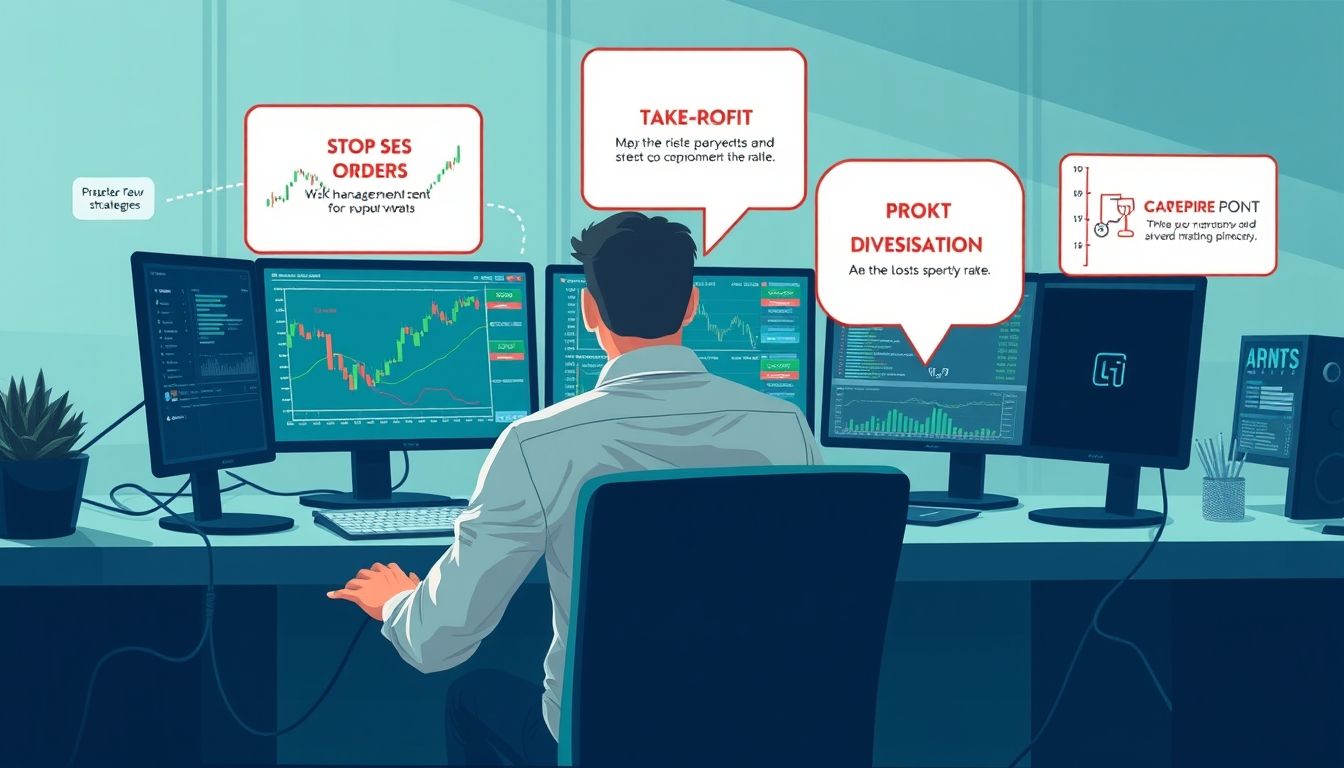مقدمة إلى إدارة الأموال والمخاطر في التداول
في عالم التداول المتقلب، تعتبر إدارة الأموال والمخاطر ليست مجرد مهارة إضافية، بل هي ضرورة حتمية لتحقيق النجاح والاستدامة. بدون استراتيجية محكمة لإدارة رأس المال وتقليل المخاطر، فإن حتى أفضل المتداولين قد يجدون أنفسهم عرضة للخسائر الفادحة التي قد تمحو مكاسبهم السابقة.
لماذا تعتبر إدارة الأموال والمخاطر ضرورية؟
تخيل أنك تبحر في بحر هائج. بدون دفة قوية وخريطة دقيقة، فإنك ستكون عرضة للأمواج العاتية والعواصف المفاجئة. إدارة الأموال والمخاطر هي بمثابة الدفة والخريطة في عالم التداول، فهي تساعدك على:
- حماية رأس المال: تضمن عدم خسارة جزء كبير من رأس مالك في صفقة واحدة.
- تقليل الخسائر: تحد من حجم الخسائر المحتملة في كل صفقة.
- زيادة الأرباح: تسمح لك بالبقاء في السوق لفترة أطول والاستفادة من الفرص المتاحة.
- التحكم في العواطف: تساعدك على اتخاذ قرارات منطقية بعيدًا عن الخوف والطمع.
الفصل الأول: فهم أساسيات إدارة الأموال
إدارة الأموال هي عملية تخصيص رأس المال المتاح للاستثمار بطريقة تضمن تحقيق الأهداف المالية مع تقليل المخاطر. تتضمن هذه العملية تحديد حجم الصفقة المناسب، وتنويع المحفظة، وإعادة التوازن بشكل دوري.
1.1 تحديد حجم الصفقة المناسب
تعتبر تحديد حجم الصفقة المناسب من أهم جوانب إدارة الأموال. القاعدة الذهبية هي عدم المخاطرة بأكثر من 1-2% من رأس المال المتاح في أي صفقة واحدة. على سبيل المثال، إذا كان لديك حساب تداول بقيمة 10,000 دولار، فلا يجب أن تخاطر بأكثر من 100-200 دولار في الصفقة الواحدة.
مثال: إذا كنت تتداول زوج العملات EUR/USD ولديك حساب بقيمة 10,000 دولار، وقررت المخاطرة بنسبة 1% (100 دولار)، وقمت بتحديد وقف الخسارة عند 20 نقطة، فإن حجم الصفقة المناسب سيكون 0.5 لوت (Lot).
1.2 تنويع المحفظة الاستثمارية
التنويع هو توزيع رأس المال على مجموعة متنوعة من الأصول المختلفة (مثل الأسهم، السندات، العملات، السلع) لتقليل المخاطر. الفكرة الرئيسية هي أنه إذا انخفضت قيمة أحد الأصول، فإن الأصول الأخرى قد تعوض هذا الانخفاض.
مثال: بدلاً من استثمار كل أموالك في سهم واحد، يمكنك توزيعها على عدة أسهم من قطاعات مختلفة، بالإضافة إلى بعض السندات أو الذهب.
1.3 إعادة التوازن الدوري للمحفظة
مع مرور الوقت، قد تتغير نسبة توزيع الأصول في محفظتك بسبب اختلاف أداء هذه الأصول. إعادة التوازن هي عملية بيع بعض الأصول التي ارتفعت قيمتها وشراء المزيد من الأصول التي انخفضت قيمتها، وذلك لإعادة المحفظة إلى التوزيع المستهدف.
مثال: إذا كان هدفك هو تخصيص 60% من محفظتك للأسهم و40% للسندات، وبعد مرور عام أصبحت نسبة الأسهم 70% والسندات 30%، فإنك ستحتاج إلى بيع بعض الأسهم وشراء المزيد من السندات لإعادة التوازن إلى 60/40.
الفصل الثاني: فهم أنواع المخاطر في التداول
قبل أن تتمكن من إدارة المخاطر بشكل فعال، يجب عليك أولاً فهم أنواع المخاطر المختلفة التي تواجهها في التداول. تشمل هذه المخاطر:
- مخاطر السوق: وهي المخاطر المرتبطة بتقلبات الأسعار في السوق.
- مخاطر الائتمان: وهي المخاطر المرتبطة بعدم قدرة الطرف المقابل على الوفاء بالتزاماته.
- مخاطر السيولة: وهي المخاطر المرتبطة بعدم القدرة على بيع أصل بسرعة وبسعر عادل.
- المخاطر التشغيلية: وهي المخاطر المرتبطة بالأخطاء البشرية أو الأعطال التقنية.
الفصل الثالث: استراتيجيات إدارة المخاطر الأساسية
هناك العديد من الاستراتيجيات التي يمكنك استخدامها لإدارة المخاطر في التداول. بعض الاستراتيجيات الأساسية تشمل:
3.1 استخدام أوامر وقف الخسارة (Stop-Loss Orders)
أمر وقف الخسارة هو أمر يتم وضعه مع وسيط التداول لبيع أصل تلقائيًا إذا وصل سعره إلى مستوى معين. يساعد ذلك على الحد من الخسائر المحتملة في الصفقة.
مثال: إذا اشتريت سهمًا بسعر 100 دولار، يمكنك وضع أمر وقف الخسارة عند 95 دولارًا. إذا انخفض سعر السهم إلى 95 دولارًا، فسيتم بيعه تلقائيًا، مما يحد من خسائرك إلى 5 دولارات للسهم الواحد.
3.2 استخدام أوامر جني الأرباح (Take-Profit Orders)
أمر جني الأرباح هو أمر يتم وضعه مع وسيط التداول لبيع أصل تلقائيًا إذا وصل سعره إلى مستوى معين. يساعد ذلك على تأمين الأرباح المحققة في الصفقة.
مثال: إذا اشتريت سهمًا بسعر 100 دولار، يمكنك وضع أمر جني الأرباح عند 110 دولارات. إذا ارتفع سعر السهم إلى 110 دولارات، فسيتم بيعه تلقائيًا، مما يؤمن لك ربحًا قدره 10 دولارات للسهم الواحد.
3.3 التحوط (Hedging)
التحوط هو استراتيجية تستخدم لتقليل المخاطر عن طريق اتخاذ موقف معاكس في أصل آخر. على سبيل المثال، إذا كنت تمتلك أسهمًا في شركة معينة، يمكنك شراء عقود بيع (Put Options) على نفس الأسهم لحماية نفسك من انخفاض سعر السهم.
الفصل الرابع: تحديد نسبة المخاطرة إلى العائد (Risk/Reward Ratio)
نسبة المخاطرة إلى العائد هي مقياس يقارن بين حجم المخاطرة المحتملة في الصفقة وحجم العائد المحتمل. بشكل عام، يجب أن تسعى إلى الحصول على نسبة مخاطرة إلى عائد لا تقل عن 1:2، مما يعني أنك تتوقع تحقيق ضعف الربح المحتمل مقارنة بالخسارة المحتملة.
مثال: إذا كنت تخاطر بـ 100 دولار في صفقة ما، فيجب أن تتوقع تحقيق ربح لا يقل عن 200 دولار.
الفصل الخامس: استخدام الرافعة المالية بحذر
الرافعة المالية هي أداة تسمح لك بالتداول بأموال أكثر مما لديك في حسابك. على الرغم من أن الرافعة المالية يمكن أن تزيد من أرباحك المحتملة، إلا أنها يمكن أن تزيد أيضًا من خسائرك المحتملة. لذلك، يجب استخدام الرافعة المالية بحذر شديد وفقط إذا كنت تفهم تمامًا المخاطر المرتبطة بها.
مثال: إذا كان لديك حساب تداول بقيمة 1,000 دولار وكان الوسيط يقدم رافعة مالية بنسبة 1:100، فيمكنك التداول بما يصل إلى 100,000 دولار. إذا تحرك السوق في صالحك، فإن أرباحك ستكون أكبر بكثير مما لو كنت تتداول بأموالك الخاصة فقط. ولكن إذا تحرك السوق ضدك، فإن خسائرك ستكون أكبر بكثير أيضًا.
الفصل السادس: تأثير العوامل النفسية على التداول وإدارة المخاطر
العوامل النفسية تلعب دورًا حاسمًا في نجاح أو فشل المتداول. الخوف والطمع والإفراط في الثقة يمكن أن تؤدي إلى اتخاذ قرارات خاطئة والتخلي عن استراتيجية إدارة المخاطر. من الضروري تطوير الانضباط العاطفي والالتزام بخطة التداول.
مثال: تجنب مطاردة الصفقات الخاسرة على أمل استعادة الأموال بسرعة، وتجنب الإفراط في التداول بسبب الإثارة أو الملل.
الفصل السابع: بناء خطة تداول شاملة
خطة التداول هي وثيقة تحدد أهدافك الاستثمارية، واستراتيجيات التداول، وقواعد إدارة الأموال والمخاطر. يجب أن تكون خطة التداول مفصلة وواقعية وقابلة للتطبيق.
عناصر أساسية في خطة التداول:
- الأهداف المالية
- تحمل المخاطر
- الأصول التي سيتم تداولها
- استراتيجيات الدخول والخروج من الصفقات
- قواعد إدارة الأموال والمخاطر
- جدول زمني للمراجعة والتعديل
الفصل الثامن: أدوات وتقنيات إدارة المخاطر المتقدمة
بالإضافة إلى الاستراتيجيات الأساسية، هناك العديد من الأدوات والتقنيات المتقدمة التي يمكن استخدامها لإدارة المخاطر، مثل:
- تحليل الارتباط (Correlation Analysis): لفهم العلاقة بين الأصول المختلفة في محفظتك.
- نموذج القيمة المعرضة للخطر (Value at Risk - VaR): لتقدير أقصى خسارة محتملة خلال فترة زمنية محددة.
- اختبار الضغط (Stress Testing): لتقييم أداء المحفظة في ظل سيناريوهات اقتصادية متطرفة.
الفصل التاسع: أمثلة عملية من السوق العربي والعالمي
تحليل حالات واقعية لكيفية تطبيق إدارة الأموال والمخاطر في الأسواق المختلفة. دراسة أمثلة لشركات أو متداولين نجحوا في إدارة المخاطر بشكل فعال، وأمثلة أخرى لفشل بسبب الإهمال في هذا الجانب.
مثال: كيف تعاملت الشركات الخليجية الكبرى مع تقلبات أسعار النفط باستخدام استراتيجيات التحوط.
الفصل العاشر: نصائح عملية لتطبيق إدارة الأموال والمخاطر بنجاح
في هذا الفصل، نقدم مجموعة من النصائح العملية القابلة للتطبيق لمساعدتك على دمج إدارة الأموال والمخاطر في روتين التداول اليومي:
- ابدأ صغيرًا: لا تخاطر بأكثر مما يمكنك تحمل خسارته.
- كن صبورًا: لا تتوقع تحقيق أرباح سريعة.
- تعلم باستمرار: ابق على اطلاع بأحدث التطورات في الأسواق المالية.
- راجع خطتك بانتظام: تأكد من أن خطتك لا تزال مناسبة لأهدافك وظروفك.
- استشر خبيرًا: إذا كنت بحاجة إلى مساعدة، فلا تتردد في استشارة مستشار مالي مؤهل.
القاعدة الأولى: لا تخسر المال. القاعدة الثانية: لا تنس القاعدة الأولى.
إدارة الأموال والمخاطر هي رحلة مستمرة تتطلب التعلم والتكيف. من خلال الالتزام باستراتيجية محكمة، يمكنك زيادة فرصك في النجاح في عالم التداول المثير والمجزأ.



